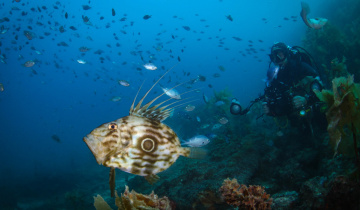Land Information New Zealand (LINZ) and National Institute of Water & Atmosphere (NIWA) today launched a new web portal providing free public access to data gathered by the Bay of Islands Ocean Survey 20/20 project.
The portal contains a vast storehouse of information about the area’s marine life and supporting ecosystems, including high-resolution seabed maps and 20000 images.
"The portal will be an important resource for future management of the Bay of Islands,” says LINZ Policy Manager Richard O’Reilly.
“The Bay of Islands coast is under increasing pressure from human activities, both land-based and marine. The huge amount of data NIWA has collected over the last two years, now freely available via the portal, will provide the public and decision makers with a much clearer picture of issues they need to focus on.”
LINZ commissioned NIWA to carry out a comprehensive survey of the region’s seafloor habitats and biodiversity as part of the Government’s Ocean Survey 20/20 programme.
The survey, which concluded in June this year, gathered high-quality data about the area’s fish, marine invertebrates, marine algae, bacteria, sediments, water quality and circulation patterns.
“In developing the portal, NIWA and LINZ have taken the lead in complying with the Government’s policy of making data widely accessible,” says NIWA Business Development Manager Neville Ching.
“The data we’ve collected will serve future research for management of the Bay of Islands as an important coastal system, with a diverse range of habitats and species,” says Ching.
Wellington-based web company, SilverStripe Ltd, built the portal and helped fund its development.
The portal is built using open data, open standards, and open-source software combined in new ways to deliver real value to scientific and government communities.
The portal will be of use to government agencies, iwi, regional and district councils, businesses, port authorities, developers, conservation groups and any individual with an interest in environmental management. The portal also provides reports, and some interpretations of the data, for the public.
“The survey results, and the portal, provide residents of the Bay of Islands with very useful information about the local marine environment and ecosystems. Users of this new portal can also learn more about the processes involved in gathering the different types of data. This is one of the most extensive coastal marine surveys ever undertaken in New Zealand,” says Ching.
The portal has just been chosen as a finalist for the New Zealand Open Source Awards 2010 for Open Source in Government category.
View the portal here: NIWA Ocean Survey 20/20
Further information about the Bay of Islands survey:
About the Web Portal Technology:
To make the data easily accessible to the public, LINZ and NIWA worked with a Wellington-based web company, SilverStripe Ltd, to design and develop an attractive website and robust software that makes the data available via a user-friendly catalogue tool as well as visually using the mapping facility. The resulting solution is fully open source and able to be freely reused to create further portals.
The portal was created using open source solutions to provide storage and web-service capabilities, supporting OGC standards (Open-Geospatial Consortium: www.opengeospatial.org).
The portal enables website users to stream the data into other applications via the OGC web-services.
The portal allows users to access information stored in distributed databases. It is presented using a powerful mapping application that puts data into a geographical context using selectable layers on maps. There are several terabytes of data.








